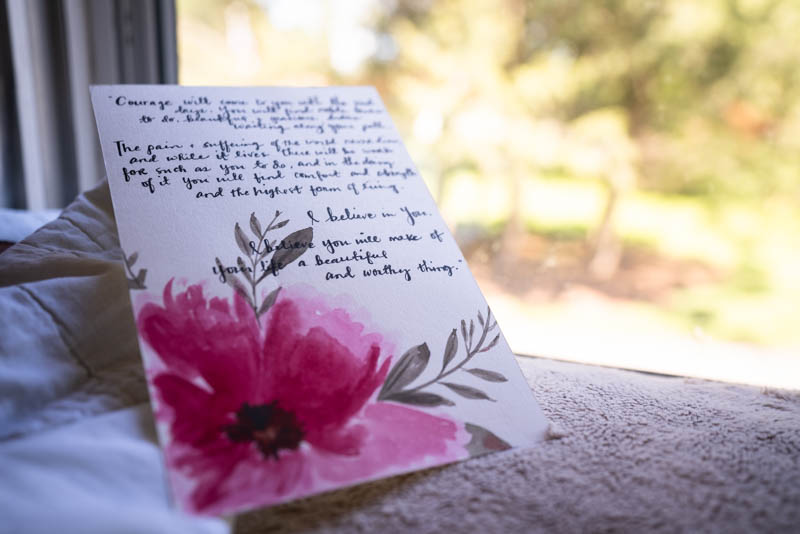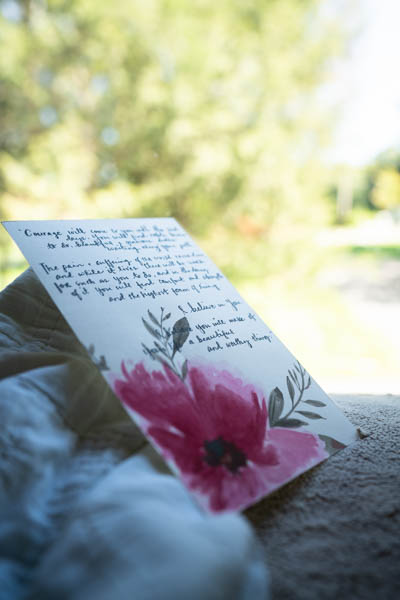Painting Leaves + Petals

Find something that inspires you and create that. I often use nature as a muse for my sketches and writings. Leaves play a big role. I even bring back a leaf or two from our morning walks to sandwich between books. So it's about time I learned how to properly paint them.
It’s all in the wrist. That’s the trick to great leaf strokes. Who knew?

The way I hold my brush determines the pressure and thus the shape of the stroke. For example, when I hold the brush closer to the fennel, my range of motion is limited. I can only go so far and so wide, and more than often, my strokes are thick because I’m putting more pressure on the brush. But let’s say I hold the brush opposite the fennel. I’m not so limited and my stroke is lighter and thinner.
Let your wrist guide you with grace.
I took several youtube classes this week teaching all about leaf strokes. One of the instructors you already know, Jenna Rainey, whom I mentioned last month when babbling on about the Color Wheel.
I was also introduced to several other artists that divulged their expertise on floral and landscape watercoloring.
Despite their different styles, some more of a realist aesthetic, while others painted with a cartoon-esque style or freeform/freeflow style, they all had one thing in common: Leaf Shape.
The Leaf Shape
At the core of every leaf (well nearly every leaf) are two shapes:
- ‘C’ shape
- ‘S’ shape
Each artist that generously shared their process and know-hows also mentioned that practice makes all the difference. Practice engages muscle memory, so after weeks of skill drills, you and I will paint a leaf without a second thought.
Reference Photo
I also assumed that to be a great artist, I had to simply imagine a subject, well to keep it consistent, let's say leaf in my mind and sketch or paint it from memory. And yes, I did just mention muscle memory, but that's a stroke, not necessarily composition.
This assumption is far from correct. Certainly there is a level of creativity that does require painting from the mind's eye and not from a reference photo -- hello, fantasy genre -- but a reference photo does not mean you’re a failure.
Type of Brush
I almost didn’t add this piece of advice, it seemed insignificant. But though subtle, it makes a huge difference. For most of these strokes, I used a round brush.
Round brushes are pretty versatile and with that wrist action I can get several different strokes in one movement. It’s magic.
The Broad Leaf Stroke
Most leaf strokes use this same technique.
- Start with your brush completely perpendicular to the page, tip of brush on the paper.
- Lightly draw a line away from the imaginary stem.
- In the same movement, shift the brush to a 60 degree angle from the paper (now it’s at a slant) and press down on the brush, to get all that paint from the belly of the brush. This should thicken your stroke by almost double in size.
- Guide the brush, with full pressure, to the size of leaf you desire and then release pressure to lightly form a point at the end of the leaf.
- And viola. That’s a leaf!
Now, if you want a thicker leaf, because diversity is a wonderful thing, simply repeat the above steps parallel to the above leaf. Essentially paint the same leaf in with the same technique side by side to the original leaf coming, coming to the same point, and it will double in size.
Some Things To Note:
- Some flowers, like roses, have large broad leaves and would probably require a two-stroke leaf like I just mentioned.
- Peonies’ leaves are also large, but they are a bit jagged. So, instead of coming to a seamless point, add a little variation to create a wild texture of laf.
- Some leaves can be longer and thinner. And even play with the different colors and values to add dimension to the piece. Give you something to look deeper at.
I’ve only just begun this practice, so I’m far from expert. Use this advice as a stepping stone I suppose. I’ve created a list of resources below to help guide you through your learning journey.
Though I’m just a beginner, I did want to share my epiphany of painting leaves with you, as it changed my whole process and mindset. My confidence grew immensely, and I want that for you, too.
Resources
- Jenna Rainey sketch leaves
- Emma skill drills (petals and leaves)
- De Winter Paper Company painting wildflowers
Thank you for reading. I do hope this was helpful! May you have a wonderful time painting the beautiful world around you.
If you enjoyed this tutorial of sorts, let me introduce to you a favorite of mine: learning about the color wheel via watercolor